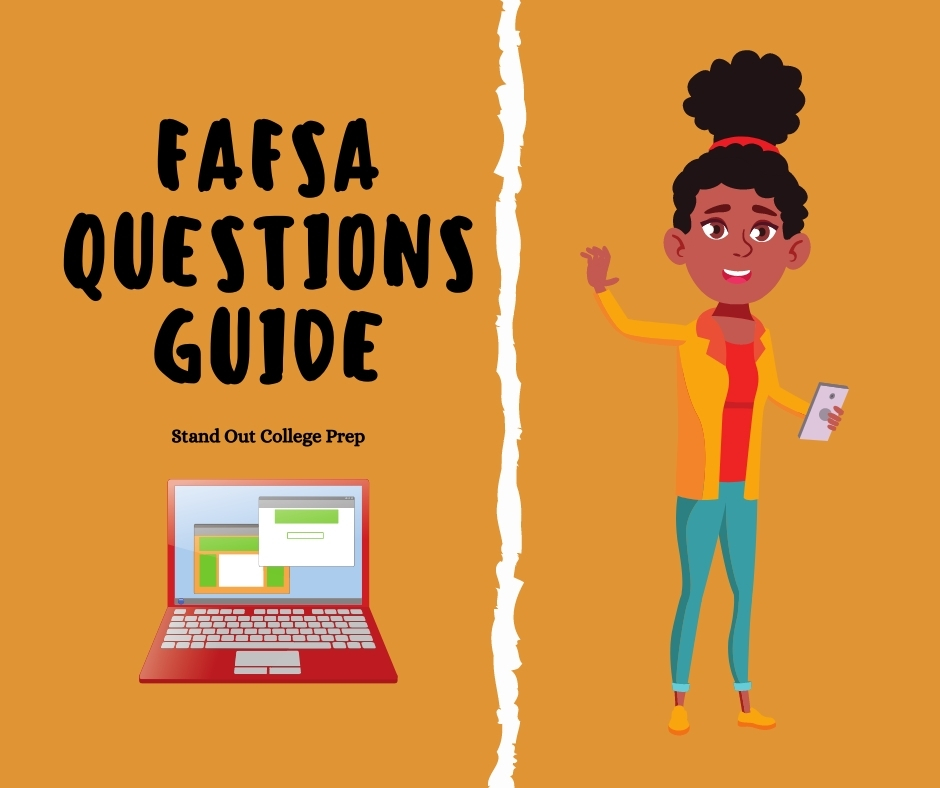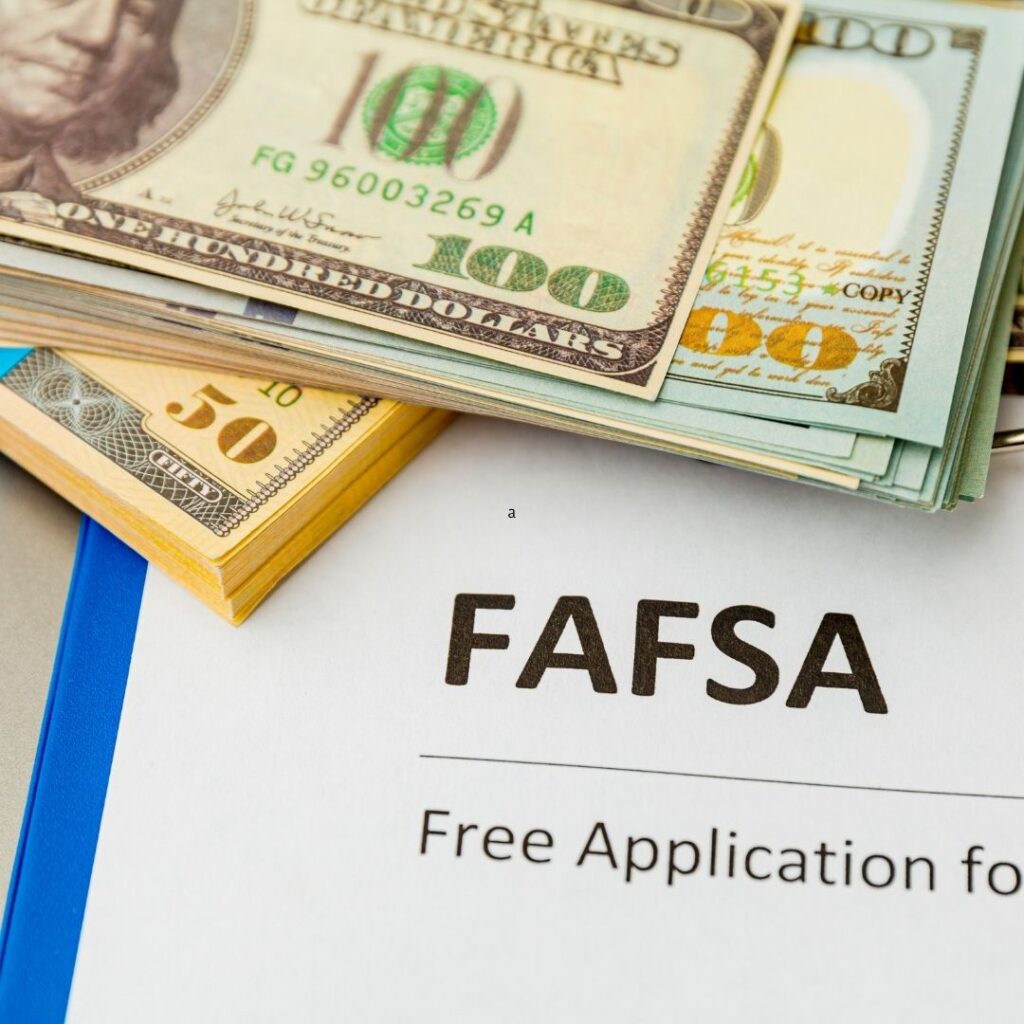Start here if you seek to apply for financial aid from colleges and universities in the United States. The form you need to complete is called the Free Application for Federal Student Aid, or FAFSA.
After you complete the FAFSA form, you’ll get an Expected Family Contribution or EFC. Your EFC tells colleges how much your family can afford to pay for college. Colleges will use your EFC and other required information (e.g., CSS Profile, your state’s application, etc.) to create a financial aid package for you.
You need to fill out FAFSA to get a financial aid package from your colleges. While not hard to complete, the FAFSA can be confusing and overwhelming, to say the least. Therefore, we’ve created this step-by-step guide that will help you question-by-question fill in the FAFSA.
The form refreshes every year on October 1, and you should aim to submit the form as soon as possible as aid is often limited.

2024-2025
Getting Started & FAQs
The first step in the FAFSA process is to visit Federal Student Aid to create an FSA I.D. With your FSA I.D., you’ll be able to sign the FAFSA form and submit it electronically. Your student and at least one parent will need to sign up for the FSA I.D. and keep it in a safe place. You’ll have this I.D. for life (even if you plan to attend graduate school later), so don’t lose it! You can visit the Federal Student Aid website to create your accounts.
FAFSA stands for the Free Application for Federal Student Aid. Here’s a PDF copy of the paper 2023-2024 FAFSA form to get a sneak peek of FAFSA before you fill it out. You can access the online version of the FAFSA form at fafsa.gov. Be sure that you have your FSA I.D. first to sign the document and submit it electronically.
Download these resources:
FAFSA Screenshots PowerPoint (Desktop)
FAFSA Screenshots PowerPoint (Mobile)
When a question refers to “you” or “your,” are they referring to the Student or Parent?
“You” or “Your” in the FAFSA stands for the Student.
What is FAFSA?
FAFSA is an acronym that stands for the Free Application for Federal Student Aid, free online application students can submit to qualify for federal grants and loans and institutional scholarships, and state aid. The time to submit a FAFSA application is approximately 20 to 30 minutes. FAFSA asks questions about dependency status, student and parent demographics, financial situation, schools attended and applying to, for example. As long as you have the materials to answer these questions, the process can take approximately 20-30 minutes to fill out and submit.
Do I have to complete the FAFSA?
It is not required but highly recommended. When you complete the FAFSA, you may be eligible for financial aid. Also, some colleges require the form for institutional aid and scholarships. Some states, like New York, require the FAFSA for state aid. Check with your college to see if the FAFSA is required.
Am I eligible for financial aid?
You are eligible for financial aid if you are:
- A U.S. citizen, permanent resident or eligible non-citizen.
- Plan to graduate from high school and will have your diploma by the time you need financial aid.
- Plan to enroll at a Title IV school.
- Will maintain a minimum GPA requirement.
When do I apply for FAFSA?
The FAFSA form refreshes for the next academic year on October 1st. You can complete the FAFSA as soon as it is available and do so as soon as possible since funding is limited.
When is the FAFSA deadline?
This year, the FAFSA application opens on October 1, 2022. It is due on June 30, 2024, for the 2023-2024 academic year. However, for many colleges, the deadline for the FAFSA is much earlier. For example, if you’re applying for early action, your school deadline may be November 1. As with all deadlines, check with your college to find out the priority deadline for financial aid. Funds are often dispersed on a first-come, first-service basis. You don’t want to delay and miss out on funding. It’s also a good idea to have a financial aid package before College Decision Day on May 1, 2023, so you can compare financial aid packages.
What information is needed to complete the FAFSA?
You’ll need to gather personal and financial information for yourself, the student, and your parents. Here’s a list of items to gather.
- Social Security numbers for student and both parents
- Student Driver’s License (if applicable)
- Alien registration or permanent resident cards, if you or your parents are not U.S. citizens
- 2021 W2s for Parents
- 2021 W2s for the student (if applicable)
- 2021 Tax Returns for Parents
- 2021 Tax Returns for the student (if applicable)
- 2021 Business Tax Returns (if applicable)
- Current bank statementsAny other financial information that tells the family’s financial story
Do I complete the FAFSA every year?
Yes, you’ll need to complete the FAFSA every year that you need financial aid for an upcoming academic year. After you submit a FAFSA the first year, the years thereafter will be easier. Your information for the renewal application will be pre-populated over. You’ll update information that has changed and verify that everything else is still correct.
Can I edit the FAFSA if I make a mistake?
Yes. After you submit the form, FAFSA will email you a Student Aid Report (SAR). You can check your SAR for mistakes. If you find any errors, you can log in to FAFSA, update them, and resubmit corrections.
What if my parents’ income has changed since the FAFSA year I am reporting?
You can speak to any changes in the special circumstances section. For example, if there is a decline in household income since the tax year reported or a change in living expenses due to a move.
I don’t think my family qualifies for aid. Do I still need to file the FAFSA?
Don’t assume you do not qualify for financial aid since there is no income maximum. Also, some colleges require the FAFSA to award merit scholarships.
What type of financial aid is available?
There are four types of financial aid: grants, scholarships, loans, and work-study. Grants and scholarships are money that you won’t have to pay back. Loans have to be repaid with interest. The federal work-study program allows you to work part-time on campus and earn money each semester. However, you have to opt-in to this program on the FAFSA form.
How much financial aid can I expect?
The financial aid package that you receive depends on your family’s Expected Family Contribution (EFC) and your college’s ability to meet your need. Some schools meet 100% of need, others not so much. You use the Net Price Calculator for an idea of how your prospective college does at meeting financial aid need.
Who applies for the FSA I.D.?
Both the Student and at least one Parent will need to apply for an FSA I.D. to sign the form electronically.
What if I (the Student) do not have a social security number?
You should not complete the online FAFSA form. Instead, download a hard copy of the 2023-2024 FAFSA form and submit it to the college aid office directly.
I am undocumented, can I fill out the FAFSA?
If you are undocumented and do not have an Alien Registration Number (ARN), then you can complete a paper application and submit it directly to the college for further assistance with financial aid. Depending on the school, you may be eligible for financial aid. Please contact us for additional guidance.
If you are an eligible non-citizen with an ARN, once that number is confirmed with the Department of Homeland Security, then you may be eligible for federal student aid.
My parents do not have a social security number, what should I do?
The FAFSA does not require that parents are citizens of the United States or have a social security number. For SS#, the parent would put 000-00-0000 and print. sign, and mail in a form to submit the FAFSA.
I have applied to 12 colleges but can only fit 10 on the FAFSA form – what should I do?
You will enter 10 schools and submit the FAFSA form. After you receive your Student Aid Report (SAR), you should log onto FAFSA, remove schools, and add two additional schools. Be sure to do this each time you change your SAR – put the original schools back, then wait a few days after it has been processed to put the other schools on.
My parents refused to let me use their financial information. Can I say that I am an independent student?
- Students are considered independent if they are:
- Over the age of 24
- Married
- Supporting dependents
- Graduate student
- Service in the U.S. Armed Services
- In legal guardianship
- Foster youth
Who is considered the Parent in the FAFSA?
Biological parents, legally adoptive parents, and step-parents if currently married to biological or adoptive parents. Aunts/uncles, grandparents, foster parents, legal guardians, siblings, and family friends are not Parents on the FAFSA.
Who’s financial information do we use?
The custodial parent(s)/step-parent and the student only. For undocumented students, even if the parent enters 000-00-0000, they should still enter financial information. The IRS or FAFSA is not connected to the Department of Homeland Security.
What is considered a household?
Parent(s), anyone the parent supports and lives in the same home or away from home for college.
What makes a parent a dislocated worker?
- Receiving unemployment benefits
- Laid off or has received a lay-off notice from a job
- Was self-employed but is now unemployed due to economic conditions or natural disaster
- is a displaced homemaker (e.g., stay-at-home-parent) who is having trouble finding work
How do I decode the different income questions?
- When asked to report all income, this includes both reported and unreported income (e.g., gifts, cash awards, money paid off the books, etc.).
- When answering the question about the amount in the savings account, this number should be after all the bills are paid for the month.
- When answering questions about business income, remember that the FAFSA considers a business to have over 100 employees. Otherwise, this section is not applicable.
- In determining child support received, do not include foster care or adoption payments
- Students must report their income information on the FAFSA
FAFSA stands for Free Application for Federal Student Aid and is often more complicated for students who have divorced parents. Here are considerations to address when filling out the FAFSA form.
Who do I put down as my Parent?
FAFSA wants you to report the biological or adoptive parent, the person who is on your birth certificate or has legally adopted you. If you live with grandparents, foster parents, legal guardians, older brothers or sisters, aunts and uncles, or widowed step parents, you would not include them as a Parent on the FAFSA.
Here are the different scenarios:
- Both parents are married. When both parents are married, you’d put both down as Parent 1 and Parent 2.
- Divorced Parents/Custodial Parent is Remarried. If your parents are divorced or legally separated, and the parent you live with most is re-married, you’d put down Parent 1 and Parent 2 (your step-parent).
- Divorced Parents/Custodial Parent is Unmarried. If your parents are divorced or legally separated, and you live with your custodial parent, you’ll enter only the custodial parent’s information into FAFSA as Parent 1.
- If you live with both Parent 1 and Parent 2 equally, you’d use the information of the parent who’s income is higher as Parent 1. If this parent is married, you’d add the step parent’s information as Parent 2.
My parents are divorced and live in different states, what do I put down for my legal residence?
If your parents are divorced and live in different states, you base your legal residency on who you live with most of the year. If you split time between both parents, then you are a legal resident of the parent who provides the most financial support.
My non-custodial parent refuses to contribute to my education. Do I need to put down their information on FAFSA?
If your non-custodial parent does not provide the majority of support for you, then you do not have to include their information on the FAFSA.
How to Answer FAFSA Questions
Introduction: Personal Identifiers
Student Identity Information. These are the required Student Identity Information fields on the FAFSA
First, Middle, Last Name, and Suffix as they appear on the student’s social security card: Enter the full legal name exactly as it appears on the Social Security card, including any suffixes such as Jr., Sr., II, III, etc.
Date of Birth, Month, Day, and Year (MM/DD/YYYY): Input student’s birthdate using the format Month/Day/Year. This information helps verify your identity.
Student Social Security Number, the last four digits will appear. The student must provide their full Social Security Number (SSN) for electronic signature purposes. The FSA-ID (Federal Student Aid ID) is linked to the SSN. If the student does not have an SSN, they can complete the FAFSA manually, but the process may be slower, and they will receive a Student Aid Report (SAR) by mail.
Individual Taxpayer Identification Number (ITIN): If the student has an ITIN, they may provide it. However, if the student does not have an ITIN, they can leave this field blank. ITINs are used by individuals who are not eligible for a Social Security Number but still need to report income for tax purposes. If the student doesn’t have an ITIN or SSN, they will still be able to submit the FAFSA, but it may affect their eligibility for certain federal financial aid programs.
Mobile phone number: Enter student’s mobile phone number if you are responsive to correspondence regarding financial aid and college matters. If you’re not the one handling these matters, it’s better to provide your parent’s contact information here.
Email address: Enter student’s email address that you regularly check. The Office of Federal Student Aid will send your FAFSA confirmation and Student Aid Report to this email address. If there are any issues with your FAFSA, you will also be contacted through this email address.
Student Permanent Mailing Address: This is student’s permanent residential address where you live and receive mail. If your parents are divorced, and you split your time between two households, you may need to follow specific instructions in the Divorced Parents section of the FAFSA guide to determine which parent’s address to use. It’s crucial to provide accurate and up-to-date contact information to ensure you receive important financial aid notifications and correspondence.
Student State of Legal Residence. When filling out the FAFSA, the “Student State of Legal Residence” is the state where you currently live and consider your permanent legal residence. It’s important to provide accurate information about your state of legal residence because it can affect your eligibility for certain state-based financial aid programs and tuition rates at public colleges and universities.
You will also need to certify how long you have been a resident of that state. If you have been a resident for less than five years, you will need to provide details about when you moved to that state.
Dependent Student’s Parent Identity Information. These are the required the parent’s identity Information fields on the FAFSA
First, Middle, Last Name, and Suffix as it appears on the parent’s social security card: Enter your full legal name exactly as it appears on your Social Security card. Include any suffixes such as Jr., Sr., II, III, etc.
Date of Birth, Month, Day, and Year (MM/DD/YYYY): Input the parent’s birthdate using the format Month/Day/Year. This information helps verify your identity.
Your Social Security Number, the last four digits will appear: You need to provide the parent’s full Social Security Number (SSN) for electronic signature purposes. The FSA-ID (Federal Student Aid ID) is linked to your SSN. If you don’t have an SSN, you can complete the FAFSA manually, but the process may be slower, and you’ll receive a Student Aid Report (SAR) by mail.
Individual Taxpayer Identification Number (ITIN): If you have an ITIN, you may provide it. However, if the parent’s does not have an ITIN, you can leave this field blank. ITINs are used by individuals who are not eligible for a Social Security Number but still need to report income for tax purposes. If you don’t have an ITIN or SSN, you’ll still be able to submit the FAFSA, but it may affect your eligibility for certain federal financial aid programs.
Mobile phone number: Enter your mobile phone number if the parent’s are responsive to correspondence regarding financial aid and college matters. If you’re not the one handling these matters, it’s better to provide your parent’s contact information here.
Email address: Enter the parent’s email address. The Office of Federal Student Aid will send your FAFSA confirmation and Student Aid Report to this email address. If there are any issues with your FAFSA, you will also be contacted through this email address.
Permanent Mailing Address: This is your permanent residential address where you live and receive mail.
Parent’s State of Legal Residence. When filling out the FAFSA, the “Parent’s State of Legal Residence” is the state where you currently live and consider your permanent legal residence. It’s important to provide accurate information about your state of legal residence because it can affect your eligibility for certain state-based financial aid programs and tuition rates at public colleges and universities.
You will also need to certify how long you have been a resident of that state. If you have been a resident for less than five years, you will need to provide details about when you moved to that state.
Section One: Personal Circumstances
Your Dependency Status. It indicates that you are classified as an independent student. As a result, you are not required to provide information about your parents to complete your FAFSA form.
Student Current Marital Status. Select the option that best describes your current situation to provide accurate information on your FAFSA. Make sure to be truthful and accurate in your response to ensure that you receive the appropriate financial aid consideration.
- Single (never married)
- Married (not separated)
- Remarried
- Separated
- Divorced
- Widowed
Student College or Career School Plans. This question asks about your grade level when you start college for the 2023-2024 school year. Select the option that corresponds to your academic progression at the beginning of the 2023-2024 school year. For example: If you’re starting as a freshman, choose “First year undergraduate (freshman).” If you’re starting as a sophomore, choose “Second year undergraduate (sophomore).” If you’re beyond your sophomore year, select “Other undergraduate (junior year and beyond).” If you are pursuing a master’s, doctorate, or graduate certificate program, choose the respective option.
When the student begins the 2024–25 school year, what will their college grade level be? This question is asking about your expected grade level for the 2024-2025 school year. Select the option that represents where you will be in your educational journey during that time. For example: If you will still be an undergraduate student, select the appropriate undergraduate level. If you will be in a graduate or professional program, select “Master’s, doctorate, or graduate certificate program.”
When the student begins the 2024–25 school year, will they already have their first bachelor’s degree?:
Answer “Yes” if you will have already earned your first bachelor’s degree before the start of the 2024-2025 school year. If not, choose “No.”
Will the student be pursuing an initial teaching certification at the elementary or secondary level?:
Answer “Yes” if you plan to pursue an initial teaching certification at the elementary or secondary level during the 2023-2024 or 2024-2025 school year. If not, choose “No.”
These questions help the government determine your eligibility for different types of federal financial aid and scholarships based on your educational status and plans.
Student Personal Circumstances: Select all that apply:
- The student is currently serving on active duty in the U.S. armed forces for purposes other than training.
- The student is a veteran of the U.S. armed forces.
- The student has children or other people (excluding their spouse) who live with the student and receive more than half of their support from the student now and between July 1, 2024, and June 30, 2025.
- At any time since the student turned 13, they were an orphan (no living biological or adoptive parent).
- At any time since the student turned 13, they were a ward of the court.
- At any time since the student turned 13, they were in foster care.
- The student is or was a legally emancipated minor, as determined by a court in their state of residence.
- The student is or was in a legal guardianship with someone other than their parent or stepparent, as determined by a court in their state of residence.
- None of these apply.
Student Other Circumstances: At any time on or after July 1, 2023, was the student unaccompanied and either (1) homeless or (2) self-supporting and at risk of being homeless?
- Yes
- No
If the answer is “Yes,” did any of the following determine the student was homeless or at risk of becoming homeless?
- Director or designee of an emergency or transitional shelter, street outreach program, homeless youth drop-in center, or other program serving those experiencing homelessness
- The student’s high school or school district homeless liaison or designee
- Director or designee of a project supported by a federal TRIO or GEAR UP program grant Financial aid administrator (FAA)
- None of these apply.
Parent’s Dependency Status. It indicates that you are classified as an independent student. As a result, you are not required to provide information about your parents to complete your FAFSA form.
Parent’s Current Marital Status. Select the option that best describes the Parent’s current situation to provide accurate information on your FAFSA. Make sure to be truthful and accurate in your response to ensure that you receive the appropriate financial aid consideration.
- Single (never married)
- Married (not separated)
- Remarried
- Separated
- Divorced
- Widowed
When the student begins the 2024–25 school year, what will their college grade level be? This question is asking about your expected grade level for the 2024-2025 school year. Select the option that represents where you will be in your educational journey during that time. For example: If you will still be an undergraduate student, select the appropriate undergraduate level. If you will be in a graduate or professional program, select “Master’s, doctorate, or graduate certificate program.”
When the student begins the 2024–25 school year, will they already have their first bachelor’s degree?:
Answer “Yes” if you will have already earned your first bachelor’s degree before the start of the 2024-2025 school year. If not, choose “No.”
Will the student be pursuing an initial teaching certification at the elementary or secondary level?:
Answer “Yes” if you plan to pursue an initial teaching certification at the elementary or secondary level during the 2023-2024 or 2024-2025 school year. If not, choose “No.”
These questions help the government determine your eligibility for different types of federal financial aid and scholarships based on your educational status and plans.
Parent’s Personal Circumstances: Select all that apply:
- The parent’s is currently serving on active duty in the U.S. armed forces for purposes other than training.
- The parent’s is a veteran of the U.S. armed forces.
- The parent’s has children or other people (excluding their spouse) who live with the student and receive more than half of their support from the student now and between July 1, 2024, and June 30, 2025.
- At any time since the parent’s turned 13, they were an orphan (no living biological or adoptive parent).
- At any time since the student turned 13, they were a ward of the court.
- At any time since the parent’s turned 13, they were in foster care.
- The parent’s is or was a legally emancipated minor, as determined by a court in their state of residence.
- The parent’s is or was in a legal guardianship with someone other than their parent or stepparent, as determined by a court in their state of residence.
- None of these apply.
Parent’s Other Circumstances: At any time on or after July 1, 2023, was the parent’s unaccompanied and either (1) homeless or (2) self-supporting and at risk of being homeless?
- Yes
- No
If the answer is “Yes,” did any of the following determine the student was homeless or at risk of becoming homeless?
- Director or designee of an emergency or transitional shelter, street outreach program, homeless youth drop-in center, or other program serving those experiencing homelessness
- The student’s high school or school district homeless liaison or designee
- Director or designee of a project supported by a federal TRIO or GEAR UP program grant Financial aid administrator (FAA)
- None of these apply.
Section Two: Demographics
Parent’s Demographics. They will be asked questions about them and their parent(s). Some of these questions will assist in determining the amount of federal student aid they may be eligible to receive for school.
The answers will not affect the student’s eligibility for federal student aid, be used in any calculations, or be shared with the schools to which the student applies. They will be used for research purposes only.
What is the student’s gender?
- Male
- Female
- Nonbinary
- Prefer not to answer
“Nonbinary” refers to a student who does not identify exclusively as male or female. “Nonbinary” does not refer to a transgender student who identifies exclusively as either male or female. Transgender students should select the gender with which they identify at the time this form is completed.
Is the student of Hispanic, Latino, or Spanish origin?
- No, not of Hispanic, Latino, or Spanish origin
- Yes, Mexican, Mexican American, or Chicano
- Yes, Puerto Rican
- Yes, Cuban
- Yes, another Hispanic, Latino, or Spanish origin
- Prefer not to answer
What is the student’s race?
White
- German
- Irish
- English
- Italian
- Polish
- French
- Other: Enter Lebanese, Egyptian, Iranian, etc.
Black or African American
- African American
- Jamaican
- Haitian
- Nigerian
- Ethiopian
- Somali
- Other: Enter Ghanaian, South African, Barbadian, etc.
Asian
- Chinese
- Filipino
- Asian
- Indian
- Vietnamese
- Korean
- Japanese
- Other: Enter Pakistani, Cambodian, Hmong, etc.
American Indian or Alaska Native
- Other: Enter name of enrolled or principal tribe(s) (Navajo, Blackfeet, Mayan, Nome Eskimo Community, etc.)
Native Hawaiian or Other Pacific Islander
- Native Hawaiian
- Samoan
- Chamorro
- Tongan
- Fijian
- Marshallese
- Other: Enter Palauan, Tahitian, Chuukese, etc.
Prefer not to answer
- U.S. citizen or national
- Eligible noncitizen
- U.S. permanent resident, holding a Permanent Resident Card (I-551), or a conditional permanent resident with a Conditional Green Card (I-551C)
- A Refugee, Granted Asylum, Parolee, T-Visa holder, or Cuban-Haitian Entrant, as per an I-94 Arrival-Departure Record from the Department of Homeland Security
- Victim of human trafficking, as per a certificate or letter granted from the Department of Health and Human Services showing a designation of “Victim of human trafficking”
- A resident of the Republic of Palau (PW), the Republic of the Marshall Islands (MH), or the Federated States of Micronesia (FM)
- A Canadian-born Native American under terms of the Jay Treaty
If none of the above apply to you, and you have any of the following documents, then you should select “Neither US Citizen or Eligible Non-Citizen.”
- Neither U.S. citizen nor eligible noncitizen
Parent Education Status: Did either of the student’s parents attend or complete college?
- Neither parent attended college
- One or both parents attended college, but neither parent completed college
- One or both parents completed college
- Don’t know
Parent Killed in Line of Duty: Was the student’s parent or guardian killed in the line of duty while (1) serving on active duty as a member of the U.S. armed forces on or after September 11, 2001, or (2) performing official duties as a public safety officer?
- Yes
- No
The student may be eligible for additional Federal Pell Grant funds once their eligibility is confirmed by their college or career school.
Student High School Completion Status: What will the student’s high school completion status be at the beginning of the 2024–25 school year?
- High school diploma
- State-recognized high school equivalent (e.g., GED certificate)
- Homeschooled
- None of the previous
If the answer is “High school diploma,” provide the name, city, and state of the high school.
- High school name
- City
- State
If the answer is “State-recognized high school equivalent,” which of the following did or will the student receive?
- GED
- HiSET
- TASC
- Other
Parent’s Demographics. They will be asked questions about them and their parent(s). Some of these questions will assist in determining the amount of federal student aid they may be eligible to receive for school.
The answers will not affect the student’s eligibility for federal student aid, be used in any calculations, or be shared with the schools to which the student applies. They will be used for research purposes only.
What is the student’s gender?
- Male
- Female
- Nonbinary
- Prefer not to answer
“Nonbinary” refers to a student who does not identify exclusively as male or female. “Nonbinary” does not refer to a transgender student who identifies exclusively as either male or female. Transgender students should select the gender with which they identify at the time this form is completed.
Is the student of Hispanic, Latino, or Spanish origin?
- No, not of Hispanic, Latino, or Spanish origin
- Yes, Mexican, Mexican American, or Chicano
- Yes, Puerto Rican
- Yes, Cuban
- Yes, another Hispanic, Latino, or Spanish origin
- Prefer not to answer
What is the student’s race?
White
- German
- Irish
- English
- Italian
- Polish
- French
- Other: Enter Lebanese, Egyptian, Iranian, etc.
Black or African American
- African American
- Jamaican
- Haitian
- Nigerian
- Ethiopian
- Somali
- Other: Enter Ghanaian, South African, Barbadian, etc.
Asian
- Chinese
- Filipino
- Asian
- Indian
- Vietnamese
- Korean
- Japanese
- Other: Enter Pakistani, Cambodian, Hmong, etc.
American Indian or Alaska Native
- Other: Enter name of enrolled or principal tribe(s) (Navajo, Blackfeet, Mayan, Nome Eskimo Community, etc.)
Native Hawaiian or Other Pacific Islander
- Native Hawaiian
- Samoan
- Chamorro
- Tongan
- Fijian
- Marshallese
- Other: Enter Palauan, Tahitian, Chuukese, etc.
Prefer not to answer
- U.S. citizen or national
- Eligible noncitizen
- U.S. permanent resident, holding a Permanent Resident Card (I-551), or a conditional permanent resident with a Conditional Green Card (I-551C)
- A Refugee, Granted Asylum, Parolee, T-Visa holder, or Cuban-Haitian Entrant, as per an I-94 Arrival-Departure Record from the Department of Homeland Security
- Victim of human trafficking, as per a certificate or letter granted from the Department of Health and Human Services showing a designation of “Victim of human trafficking”
- A resident of the Republic of Palau (PW), the Republic of the Marshall Islands (MH), or the Federated States of Micronesia (FM)
- A Canadian-born Native American under terms of the Jay Treaty
If none of the above apply to you, and you have any of the following documents, then you should select “Neither US Citizen or Eligible Non-Citizen.”
- Neither U.S. citizen nor eligible noncitizen
Parent Education Status: Did either of the student’s parents attend or complete college?
- Neither parent attended college
- One or both parents attended college, but neither parent completed college
- One or both parents completed college
- Don’t know
Parent Killed in Line of Duty: Was the student’s parent or guardian killed in the line of duty while (1) serving on active duty as a member of the U.S. armed forces on or after September 11, 2001, or (2) performing official duties as a public safety officer?
- Yes
- No
The student may be eligible for additional Federal Pell Grant funds once their eligibility is confirmed by their college or career school.
Section Three: Financials
Your Finances. The FAFSA form helps determine your ability to pay for school. In this section, we ask about your financial information.
What if you have special Financial circumstances?
Response Don’t Affect Federal Student Aid Eligibility. You answers to these questions will not affect the student’s eligibility for federal student aid or federal benefits.
Federal Benefits Received: At any time during 2022 or 2023, did the student or anyone in their family receive benefits from any of the following federal programs?
Select all that apply:
- Earned income credit (EIC)
- Federal housing assistance
- Free or reduced-price school lunch
- Medicaid
- Refundable credit for coverage under a qualified health plan (QHP)
- Supplemental Nutrition Assistance Program (SNAP)
- Supplemental Security Income (SSI)
- Temporary Assistance for Needy Families (TANF)
- Special Supplemental Nutrition Program for Women, Infants, and Children (WIC)
- None of these apply.
Family Size: Is the student’s family size different from the number of individuals claimed on their 2022 tax return?
Family size includes: The student (and spouse), the student’s dependent children (even if they live apart due to college enrollment), and other people living with the student now. Include these dependent children and other people only if the student will provide more than half of their support between July 1, 2024, and June 30, 2025.
If YES
Enter the number of children or dependents who live with the student and will receive more than half of their support from the student between July 1, 2024 and June 30, 2025.
Do not include the student applicant.
If No
Number in College: How many people in the student’s family, including the student, will be in college between July 1, 2024, and June 30, 2025?
Student 2022 Tax Return Information: Refer to the student’s 2022 tax return to answer the following questions.
Convert all currency to U.S dollars.
Did the student receive the earned income credit (EIC)?
- Yes
- No
- Don’t know
Amount of college grants, scholarships, or AmeriCorps benefits reported as income to the IRS
The student paid taxes on these grants, scholarships, or benefits. These usually apply to those renewing their FAFSA form, not to first-time applicants. If the student is married, include the amount their spouse reported.
Foreign earned income exclusion
Annual Child Support Received: Enter total amount the student received in child support for the last complete calendar year.
Student Assets:
- Current total of cash, savings, and checking accounts
Don’t include student financial aid.
- Current net worth of investments, including real estate
Don’t include the home the student lives in. Net worth is the value of the investments minus any debts owed against them.
- Current net worth of businesses and investment farms
Enter the net worth of the student’s businesses or forprofit agricultural operations. Net worth is the value of the businesses or farms minus any debts owed against them.
Section Four: Colleges
Colleges. On the FAFSA online application, you can list up to 10 colleges and universities. The paper application allows you to list 4. The schools you list are confidential and will not be shared with other schools on your list. You should list all the schools you apply to, even if you have not submitted your application. If you have more than ten schools, you can submit the FAFSA with 10. And then, after the form is processed (following receipt of the Student Aid Report), you can log-in, revise your application to include the additional schools, and resubmit the form.
Please make sure you check with the added colleges to confirm they received the SAR. To find FAFSA codes for your school, you can use the search feature in FAFSA or use this list.
Where should we send the FAFSA information?
Search and select colleges and career schools. You can add up to 20 colleges and career schools to the FAFSA form.
If you can’t find school when searching by School Name or State, try searching by School Code.
Enter the schools that should receive the student’s FAFSA information.
- Federal School Code
- College name
- Address
- City
- State
Section Five: Signature
Student Consent, Approval, and Signature: If you do not provide approval by filling in the circle below and providing your signature, you will not be eligible for federal student aid.
Approval to transfer federal tax information from the Internal Revenue Service (IRS)






